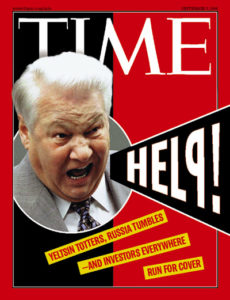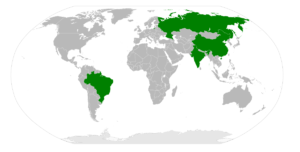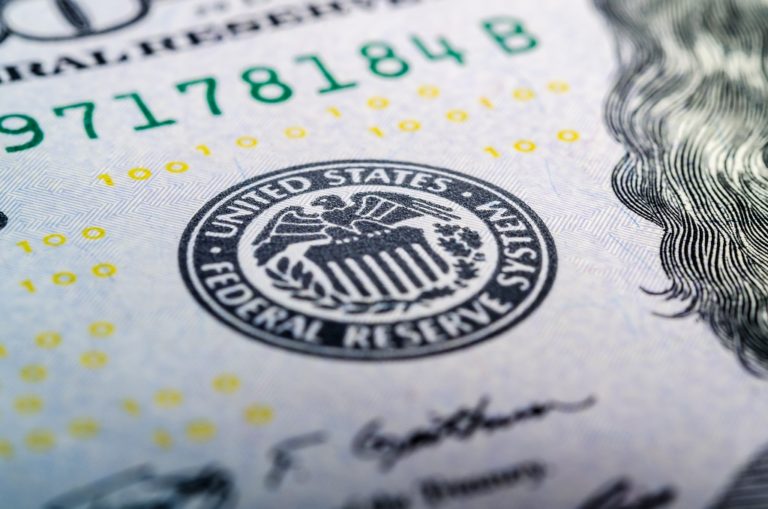Investing in emerging markets is arguably one of the riskiest investment categories for individual and institutional investors alike. Yet, these are the countries that offer phenomenal growth thanks to better demographics, resource-rich opportunities and less competition from the majority of international investors.
In order to be prepared for investing in emerging markets, to avoid the many pitfalls and risks that come with investing in this asset class, and to be ahead of the competition it’s absolutely vital to understand its lessons in a historical context and to apply these lesson in a suitable investment strategy.
In this article, we have a look and summarize the most important investment lessons and how you could implement the most optimal investment strategies for your own benefit.
[Read here why you should be investing in Emerging Markets]
Investing in Emerging Markets – A History
Investing in distant and unknown countries is as old as investing itself, but the history of modern emerging markets investing is only about 30 years old. It all started with a major economic crisis. The curious reader should keep this mind when we discuss investment strategies, risk and portfolio management.
The Beginnings of Emerging Markets Investing
Fighting high inflation forced then Chairman of the Federal Reserve Paul Volcker (from August 1979 to August 1987) to hike rates to 20% at the beginning of his tenure. The US dollar appreciated, and borrowing money became extremely expensive — causing a global recession in the years that followed. All of a sudden the entire world had to deal with a new economic reality and many countries couldn’t deal with it.
The first country that fell was Mexico. Heavily indebted from years of easy borrowing in the 70s, it was poorly prepared for a new macroeconomic environment. Due to rapidly shrinking currency reserves, the Mexican government was forced to devalue its currency. On August 1982 it announced that it was running out of foreign currency reserves, and defaulted on its debts.
Due to Mexico’s default, many other less financially sound countries came under heightened scrutiny. This led to a sharp decline in lending to countries that needed funding the most. Many Latin American states, but also countries in Eastern Europe and Africa followed Mexico’s lead — all burdened by high USD denominated debt accumulated throughout the 70s they buckled under high-interest rates, a strong dollar, and lenders unwilling to continue lending.
A good name for poor economies
It was during this period of global financial doom that an unknown bureaucrat came up with the term – emerging markets. Antoine van Agtmael, employed by International Finance Corporation (IFC), a division of the World Bank, worked on a project that he called “a set of promising stock markets, lifted from obscurity, thereby attracting the investment they needed to thrive.” Naming his new endeavor was more of a challenge. When presenting his idea under the name of “3rd World Investing” to a group of high finance and politicians, it didn’t get much traction. Only after spending a weekend brainstorming he finally came up with a better term – “emerging markets.”
According to van Agtmael, he hoped to evoke “progress, uplift, and dynamism.” This did the trick. The new term was widely accepted and consequently saw a comet-like rise among investors around the world in years to come.
The Brady Plan
Van Agtmael’s initiative came to fruition in 1986. The IFC officially engaged in a campaign to encourage capital market developments in the less-developed countries. Initially, only a handful of institutional investors invested a small sum of US$50 million. But over the following months more and more investors warmed up to the idea of supporting these economies. A year later, in 1987, MSCI developed its first emerging-markets indexes, making it easy for institutional investors to attract capital to restart investing in emerging economies.
The IFC’s efforts paid off. Interest in investing in emerging markets increased, buoyed by a drop in global interest rates and an improving economy in the USA. In this new mood of optimism, the so-called Brady Plan was initiated in 1989 under the leadership of US Treasury Secretary Nicholas Brady, who served under Reagan and Bush Senior. The goal was to improve the finances of struggling economies and to accelerate their economic recoveries. The restructuring plan was simple: replace outstanding debt by selling long-term dollar-denominated bonds, backed by the US Treasury. These fixed income securities became known as Brady bonds. It was a huge success.
 The same year, Mexico was able to persuade its bank creditors to accept a reduction in the principal they were owed, in return for Brady bonds. Other developing countries followed suit with the same success. Attracted by good yields, and the backing of the US Treasury, institutional fund managers felt comfortable in putting more and more money in these bonds. It created an entirely new asset class in their asset allocation models, known today as “emerging markets fixed income” investing or “emerging markets bonds investing.”
The same year, Mexico was able to persuade its bank creditors to accept a reduction in the principal they were owed, in return for Brady bonds. Other developing countries followed suit with the same success. Attracted by good yields, and the backing of the US Treasury, institutional fund managers felt comfortable in putting more and more money in these bonds. It created an entirely new asset class in their asset allocation models, known today as “emerging markets fixed income” investing or “emerging markets bonds investing.”
The Case of Mexico
Brady bonds were so successful that a whole range of new bond indices was issued, which encouraged the launch of more emerging markets funds. It was a reinforcing positive cycle that saw only winners – for a while.
In this favorable environments, supply couldn’t keep up with demand encouraging the same countries that struggled only a few years prior to issue more and more bonds with dubious credit, and with worsening fiscal discipline. Apparently, they didn’t learn their lessons, and neither did the majority of international investors as the following financial crisis demonstrates.
At the launch of the North American Free Trade Agreement (NAFTA) on January 1, 1994, everything looked fine. Mexican businesses and the Mexican government enjoyed even easier access to international capital markets, and Mexico was hot in the eyes of international creditors and investors.
However, the honeymoon was soon over. A string of political incidents, that saw its culmination in the assassination of presidential candidate Luis Donaldo Colosio in 1994, quickly turned investors’ sentiment. In response, the Mexican central bank intervened in the foreign exchange markets to maintain its peg to the U.S. dollar by issuing dollar-denominated public debt to buy to support the peso. The result was that to keep the peg, the Mexican government had to buys pesos to maintain the peg — which in turn resulted in the collapse of the peso.
The Rise of Global Macro Funds
Meanwhile, professional speculators recognized that the recent developments had overvalued the peso. They started to take massively leveraged positions against the currency, that accelerated the capital flight out of Mexico, putting even more downward pressure on the peso. The Mexican government saw itself forced to purchase its own treasury securities to dampen the effect of rising interest rates and to calm investors, but this had the exact opposite effect. It became obvious that the government would soon run out of money.
On December 20, 1994, the Mexican central bank devalued the peso, sealing Mexico’s financial demise. At that moment, all hell broke loose, and two days later, the bank was forced to let the peso float freely, accelerating its decline. Several of Mexico’s banks collapsed amidst widespread mortgage defaults. Mutual funds and other institutional investors who invested in Mexico’s stocks and bonds began liquidating their positions in earnest. But it didn’t stop there. As is usually the case in complex systems that are defined by systemic risks, the selling spread to other asset classes and markets. 1994 would go into the history books as one of the worst bond market performances on record.
A few hedge funds, however, who foresaw and bet on the peso’s decline had a field day. Known among market insiders as Global Macro strategies, they made a name for themselves. When George Soros, the most glorified Global Macro investor, became known for breaking the Bank of England only two years prior, politicians and bankers knew who they were dealing with. These new types of funds, with their esoteric investment and trading strategies, would dominate emerging markets investing for years to come. The Mexican economy, on the other hand, would experience hyperinflation of around 50%, a severe recession and rising unemployment that would lose the nations more than a decade.
The Rise of Asian Emerging Markets
The few investors who profited from Mexico’s currency demise learned their own lessons. They were able to draft a blueprint to making large amounts of money quickly, and they were eager to test it somewhere else in the world. Scouring for new victims, they found them in Asia less than two years later. The official date for the next string of crises was July, 2nd 1997 when Thailand announced the end of the Thai baht peg to the USD.
The Beginnings
The origins of Asia’s financial demise were in retrospect as simple as they were obvious. As was the case in Mexico in 1994, most South-East Asian currencies were pegged to the USD to encourage lending and investments. And lend they did! Institutional investors and banks around the world bent over backward to lend to local banks, businesses, and governments in the entire region.
In this moment of easy money, parties on both sides saw no need to hedge their currency risks. In fact, the whole incentive was to borrow heavily in USD and JPY at lower interest rates and invest in developing countries at much higher rates, resulting in a stream of capital to Asia’s young economies. And why not? The currencies were pegged to the USD, guaranteeing a fair repayment in the future.
But between 1995 and 1997 the USD began to rise. As the USD, rose so did the currencies pegged to it, resulting in a widening of those countries’ current account deficits. In Thailand’s case, the deficit reached 8% of GDP in 1996. Capital flowed out of the country at an accelerated pace, and its foreign reserves started to dwindle. It was clear that the USD peg was unsustainable — resulting in massive currency depreciation.
The first to notice was, of course, the new breed of hedge funds. They started to take leveraged bets against the Thai baht, accelerating the flow of capital out of Thailand. Like in the case of Mexico, it reached a point where Thais central bank was no longer able to defend its currency. In July 1997, the game was over.
The majority of international investors and lenders were caught off guard. They panicked, worsening the decline of the baht by selling anything they were able to bring out of the country. Everything was up for grabs. Local stocks, real estate — anything that had a faint hope of financial value.
In the process, those companies that had large unhedged USD loans on their books suddenly faced insurmountably high debt repayments in their domestic currency. Large-scale bankruptcies were the consequence, deepening the already severe recession.
Pandemic Urges
Like in the case of Mexico in 1982, the panic selling didn’t stop then and there. Investors quickly pulled money out of countries with similar economic characteristics and structural problems. It spread like wildfire to neighboring countries. Reading the financial news was like getting updates on a zombie epidemic. Indonesia, South Korea, and Thailand were the countries most affected by the crisis. Hong Kong, Laos, Malaysia, and the Philippines were also hurt by the slump.
More established economies such as China, Singapore, or Taiwan were affected by the dwindling confidence of international investors and the lack of appetite for risk. Even Japan saw its stock market decline substantially. When the contagion spread to South Korea, the Korean Won fell like a stone in November 1997. In 1998, Indonesia, Malaysia, South Korea, and Thailand saw their real GDP per capita shrink by an average of 11%, Indonesia lost 13.7%, South Korea 5.5% and Hong Kong 5.1%. It took months to process the financial crises and to clean up their systems.
IMF stepping in
It was time to draw a line and the International Monetary Fund (IMF) stepped in with a rescue package. The packaged included stringent terms on the debtor country, something many Koreans still fume about today. In retrospect, though extremely painful and in many cases unfair to the majority of the population, it was the necessary evil, as the thriving economy in South Korea shows today.
But there was one last country that would take center stage before an unprecedented bull market in history — Russia.
From Russia with Love
On August 17th, 1998, the Russian government announced that the Russian Central Bank would devalue the ruble and default on its debt. Declining productivity, a high fixed exchange rate to foreign currencies, and an utterly incompetent and corrupt government would be the main reasons for a chronic fiscal deficit. In light of a strengthening US dollar and heightened financial scrutiny, the announcement had only been a matter of time.
Yet the results and consequences were the same. From Russia, the lack of investor’s confidence spread to many neighboring countries causing economic hardship and high unemployment. Even far-distant economies such as Brazil and Argentina would be affected by the shock waves. Argentina suffered through from 1998 to 2002 when it eventually gave up its peso-dollar parity in 2002, making way for some painful but necessary economic adjustments.
BRIC and the love for Acronym Investing
Since Russia’s default in 1998, many emerging markets went through a painful period of adjustment and soul-searching. But at the centers of finance, markets experienced a period of growth and prosperity that would trickle down to countries with less developed economies. In a period of relative calm, a once shunned asset class was working quietly at its comeback. Among the first to notice was an economist working at Goldman Sachs Asset Management.
Legend has it that in 2001 James O’Neill, British economist, and former Conservative government minister, came up with a new Acronym to entice clients while working for Goldman Sachs Asset Management: BRIC. In O’Neill’s words, these economies would “symbolize the shift in global economic power away from the developed G7 economies.” The message was clear. The world was underestimating the economic potential that was brewing up in those countries. It would be time to pay more attention to these four countries – and to China in particular.

Yet O’Neil’s audience and the world weren’t convinced. Other early movers, such as Jim Rogers, were ignored or even ridiculed. But O’Neil’s message was intriguing for a few, and his acronym was catchy. When China delivered double-digit GDP growth rates that economists in the West could only salivate over, the topic of BRIC investing and emerging markets investing, in general, became hot. Investors around the world wanted some of the action.
Emerging Markets – A strong comeback!

In 2006 Goldman Sachs launched the first BRIC fund. Its assets under management rose quickly to over $700 million, and competing firms were quick to copy Goldman. A handful of similar BRIC-themed emerging market funds were launched, and on Wall Street, the term BRIC became came to mean fantastic gains and phenomenal growth.
Unfortunately, Goldman Sachs timing wasn’t the best even though the fund showed promising returns – like any asset class in the wake of the subprime crisis, it lost most of its gains. However, contrary to other asset classes, BRIC themed funds enjoyed a miracle recovery in 2009, led by the world’s new economic powerhouse – China.
All was fine for a couple of years. Returns were very attractive and assets under management increased rapidly as investors were lured in by stellar track records. But the curse of emerging market would strike again – and this time it was particularly hard on those who were late to the party.
Emerging Markets Lessons relearned
Goldman’s own BRIC fund peaked in late 2010. After that, a long and painful decline would set in ending in 2015 when Goldman finally pulled the plug. The fund lost 21% in the last five years, leading to investors fleeing in droves. In the end, the once iconic BRIC fund had lost 88% of its assets.
There were also winners. The first movers who invested early on at very favorable prices. Goldman Sachs’ best and most loyal customers got first dibs. Other well-connected investors with a knack for risk and an understanding of valuations similarly enjoyed bumper profits. But by the time BRIC became headlines news and the masses started investing in droves, early investors were pulling out. Retail investors who jumped on the BRICs bandwagon too late lost a substantial amount of money while paying exorbitant management fees.
Ask yourself if the story doesn’t sound all too familiar in February 2018 – for a very different hot asset class.
“What the wise do in the beginning, fools do in the end.”—Warren Buffett
The Mexican crisis and the Asian crisis reaffirmed some simple lessons when it comes to investing in emerging markets.
The importance of changing factors
When the big G7 currencies experience increased volatility it can upset the global status quo with emerging markets suffering the most. Imbalances in the global economic system are bound to occur attracting modern hedge funds to exploit any weaknesses in the system. It usually forces weaker economies to adjust involuntarily.
Contagion and Systemic Risks
The Mexican Tequila crisis was the first international financial crises ignited by capital flight and not by changing interest rate changes. A simple a loss of confidence by investors was able to ignite a sequence of unfortunate events with resulting capital flights and a decline of asset prices.
Once the collective trust in one country or system is gone, everything else will be in jeopardy. Countries in the same region or even across regions with similar characteristics will be vulnerable. A unified force of vultures and global speculators will force the issue to accelerate an outcome in their favor. They are not be underestimated as central banks and governments around the world can confirm.
Understanding Cycles and their Players
Where in the post-war era mainly banks would profit from rising economies, mutual funds and large institutional investors would profit from emerging markets in the 80s. In the 90s a new species of investors would emerge dominating the scene for decades to come. It is in this environment of giant elephants and hyenas that individual investors will need to fend for themselves. If you want to survive or even profit from the mistakes or early decisions by a few astute pros, it requires a particular mindset and strategy which will be discussed in the following part of this emerging markets investing series.
Investing in Emerging Markets economies has always been connected with investing in natural resources and initially investing in large infrastructure projects, such as the power or train grid.
In recent years, however, its growth has become more diverse, more robust and balanced. From a growing middle class to crafty consumers and a young tech-savvy population, it appears that many emerging markets are less dependent on the whims of foreign capital or western financial institutions. China and India, in particular, are quickly developing what appears to be a sustainable and growing middle class that will lay the foundation for robust consumer markets.
Conventional Emerging Markets Investment Strategies
1) The Traditional Asset Allocation Approach
Since the beginning of investing in high growth economies, institutional investors and individuals have been discussing what the best emerging markets investment strategy could be. How the majority approached this question could be seen from the history of emerging markets investing and as we know it wasn’t always pretty.
Sovereigns’ approach provides a fresh perspective and a valid alternative to how we as individuals should be investing in emerging markets. Their opportunistic investment approach stands in stark contrast to the conventional approach still favored by institutional and retail investors alike.
When Sovereign bought, most money managers would sell, and when Sovereign sold or reduced their positions, they would be buying. Let’s have a look at traditional money management and their approach to emerging markets investing.
Specialized Emerging Markets Mutual Funds
From advisor to emerging markets fund: When you enter a local bank branch, a friendly banker will discreetly analyze your current financial situation, income, age, and financial goals. Based on your answers, they will assess and set financial targets, such as your return goals, investment horizon, and risk profile (whether you are a high risk, medium risk, or low-risk taker). Then, they will devise an investment matrix to offer you the appropriate financial products.
The most important step in the whole procedure is the asset allocation decision, which is based on your answers to the questionnaire. This process divides your investment into asset classes that are considered appropriate for your risk profile. The most common assets classes are stocks, bonds, and real estate.
Often, you will be presented with a pie chart slide depicting how much you should be allocating to each asset class, starting with default asset allocation models (where you put the majority in bonds, followed by stocks, or real estate).
Within each asset class, they will then recommend several investment funds, from either in-house offerings or third party providers, to fill up your personalized allocation model. Many times they will advise you to buy several funds at the same time for each asset class in question. Extra diversification not only within funds but also across fund providers couldn’t hurt – right?
Here is where today’s modern emerging market funds enter. Depending on how popular emerging markets investing is in the financial press, advisors will recommend adding a few emerging market funds to your mix of bonds and equity funds.
Their arguments will be based on past track records, the enormous growth forecasts by their expert research teams and the general sexiness of investing in exotic countries. It is also based on how top management at banks and private banks are pushing these high margin products on their army of financial advisors to promote to their clients.
From there, this portion of the money will flow to one of the many emerging market fund providers, where a team of MBA-educated professionals will strictly follow their orders as described in the shiny investment pamphlets you most likely held in your hands at your advisory’s office.
Here is a perfect example of such orders, taken from Templeton’s website on of the leading providers of emerging market funds:
The typical Emerging Markets Mutual Fund
The fund seeks long-term capital appreciation by investing primarily in equities of companies in emerging markets. The fund may also invest in companies that trade in emerging markets, or that trade elsewhere in the world and earn at least 50% of their revenue from production or sales in emerging markets.
It’s only common sense that a financial advisor who needs to earn a living won’t sell you anything that would send you sprinting out of their office like you’d been bitten by a tarantula. They offer products that are hip, widely spoken of, and that can earn them a decent commission.
On the other hand, it’s only natural that professional portfolio managers only do what they are supposed to be doing with the money entrusted by their clients. Besides they want to hold on to it as long as possible so that they can earn a management fee.
But this is where the chain of unfortunate investment decisions starts that can be particularly fatal when it comes to investing in emerging markets. Remember – popularity investing has never been a guarantor of investment performance especially for emerging markets.
2) The Passive Approach – The Low-Cost Alternative
Rather than making adjustments to a flawed approach of popularity investing, the money management community’s attention moved from the investment process to the investment products themselves. In their eyes, the real issue with losses and subpar performance was quickly identified – horrendous fees charged by active managers.
In order to counteract their clients’ moronic behavior of buying late and selling late, and paying high fees in the process, a special camp of the investment management industry had been working on a technological revolution since the late 1970s. It would take care of the high fees issue, and incentivize customers to stay invested at all times – Index funds and ETF investing – so-called ‘passive’ investment vehicles.
The theory behind it is that in a new age of algorithmic, computerized trading, index funds and ETFs will give you maximum diversification at low cost while reaping market performance as measured by a chosen benchmark index. Being invested at all times and adding to them on a monthly basis discourage you from buying late and selling even later while participating in whatever is hot among investors.
Emerging Markets Index Funds and ETF investing
This revolutionary doctrine would be applied to emerging markets investing in earnest from 2010, and with great success. Money managers would either allocate a portion to emerging markets through index funds and ETFs to their own fund compositions, or they would give clients the opportunity to decide for themselves through a whole new range of individual emerging market index funds and ETFs.
ETF products like the BlackRock iShares Core MSCI Emerging Markets ETF (IEMG), continue to see astounding growth in assets. According to MarketWatch.com “Year-to-date, investors have added nearly $3 billion in new assets to IEMG alone, a tally exceeded by just two other ETFs “IEMG added $16.57 billion in new capital last year, making it 2017’s fourth-best ETF in asset-gathering proficiency.”
The leading players in this field are BlackRock with their iShares Emerging Markets series and Vanguard, that has a broad range of emerging markets index funds and ETFs.
Developing the Best Investment Strategy for Emerging Markets
The Sovereign Approach
In late 1986, an unknown family office called Sovereign, with roots in New Zealand, and $10 million under management, made its debut investment. Only a few months prior, the family had sold its retail business in New Zealand. Now they were eager to deploy their assets in global capital markets.
Surprisingly, their first investments wasn’t a managed fund by a leading broker or private bank from Switzerland. They weren’t interested in the standard sales talk of asset allocation strategies and portfolio theory, that would spread their money in hundreds of companies and bonds in the US and Europe. Instead, they would buy one piece of real estate in Hong Kong putting their entire $10 million on the line.
Lead by the two sons, Richard and Christopher Chandler, the family office bought a 22-story building in heart of Hong Kong for $27.6 million in February 1987. Only 4 years later they would sell the building for more than $110 million, boosting their wealth from $10 million to over $40 million in the process.
In an interview the brothers would explain their rationale: Real estate prices in Hong Kong were depressed trading for 70 percent lower than their peak prices in 1981. Investors were spooked by the ongoing negotiations of Hong Kong rejoining China to be finalized in 1987. The two brothers noticed the opportunity, read the new treaty with China, and decided that the general fear of uncertainty was overblown. The rest is history.
Searching and Waiting for Opportunities
The Chandlers would use this experience as a blueprint of a very profitable investment strategy that generated an investment track record any conventional asset manager can only (wet) dream about. In the years that followed they would refine their investment approach by replicating the same type of investment over and over again – often in emerging market economies.
For example, in the early 90s, they would buy Brazilian Telecom stocks and Venezuelan Power bonds at bargain base prices and made a killing. They also bought a whole range of Brady Bonds when the investing public was just beginning to catch on.
After that they bought Russian assets in oil and gas, only to sell most of it at the height of the Russian stock market boom in 1997. Knowing Russian capital markets, they repeated the same spiel 10 years later. This time they would buy Russian banks at the height of the subprime crisis, which suffered like any financial institution from the general fear of a global financial meltdown. They doubled their money within a year when market conditions returned to normal in 2009.
In between their Russian investments they would buy Japanese banks when there was a total financial meltdown between 2002 and 2003. After that, they bought Chinese assets when the BRIC acronym was just starting to make rounds in the boardrooms of large asset managers.
Favorable Valuations and Focus Portfolio Management
On the surface, the Chandlers followed a very simple value investing strategy with a “focus portfolio” investment approach. They searched for mispriced assets all over the world, did their research, and made concentrated commitments when they understood the risks involved.
Their investments would usually end when the general investment public got interested in mispriced assets. The lapse could last a few years or just a couple of months depending on capital flows and global investment trends.
In many cases, they would sell too early or not capturing the entire boom phase. They weren’t bothered with this, as their average annualized returns were far superior to any conventional asset allocation strategy. It wasn’t their primary goal to have perfect timing or to beat benchmarks. Their objective was to make a killing with each investment they made. For that, they were willing to wait and to do their homework.
Sometimes they kept on holding a few strategic long-term investments through the boom and bust phases, adding to them during stronger corrections. China is a good example – they still hold investments they made in the mid-2000s, with some fantastic capital gains accumulated over the years.
For the investments they kept for many years, they actively worked to enhance value. In case of real estate, hey would make improvements such as renovations or upgrades. In the case of equity investments, they would call for corporate governance improvements that resembled the work of professional activist investors.
This small family office that started out with $10 million would become titans of international value investing. At the height of their success as a single family office, they would amass a fortune of more than $5 billion – all this with a simple strategy of understanding value and the nature of capital markets.
How to invest in Emerging Markets the 80/20 Way
The Disadvantages of Conventional Strategies
Unexpected Side-Effect with Similar Outcomes
 The result is that anyone believing the new doctrine joins the herd, with all its consequences and side effects. And contrary to all the risk diversification mantra, only three institutions combine more than $16 trillion assets under management of a global $40 trillion pie. Frighteningly, this concentration seems to be accelerating. How is this for efficient risk diversification?
The result is that anyone believing the new doctrine joins the herd, with all its consequences and side effects. And contrary to all the risk diversification mantra, only three institutions combine more than $16 trillion assets under management of a global $40 trillion pie. Frighteningly, this concentration seems to be accelerating. How is this for efficient risk diversification?
Let’s be honest: What is proclaimed as being passive isn’t passive at all. Decisions of whether to overweight and underweight, regional allocations etc and which service provider to choose from still have to be made with passively managed products.
An individual investor still has to pick their private banker and an investment advisor still has to decide which ETF or index fund to offer their clients, and that isn’t as easy as it used to be. According to industry experts, there are now more ETFs and index funds than the individual securities they pool together.
So there’s plenty of room to mess up the selection of the right advisor, the right provider and the right index funds and ETFs that could ruin your overall benchmark performance. Here is where the real risks for individual investors lurk. As the last financial crisis in 2007 proved, investors would panic and will do so in the future, with or without index funds and ETFs.
The Institutional Imperative
Traditional money management has always been dominated by large investment pools, controlled and managed by giant investment firms or financial institutions. In the past, it was institutions like Bank of America or Citigroup that lead the way in promoting and investing in emerging markets. Today, BlackRock, Vanguard or active managers such as Templeton or Fidelity dominate the market for high growth economy investing.
As gatekeepers to international stock markets, they control the investment process and flow of capital around the world. But having a dual objective of delivering high performance to their investing clients while also satisfying their own shareholders is usually riddled with conflict of interests. The competitive forces of free market economies dictate the mission of being profitable, which in turn determines their investment approach. And their business mission is clear: Amass Money!
This, however, often leads to what Buffett calls the “institutional imperative” among money manager – a herd mentality that results in behavior contrary to what common sense would dictate. As a fellow value investor would sum it up nicely.
It’s the tendency for organizations to:
– resist changes in direction;
– make less than optimal use of corporate funds;
– support even very foolish initiatives;
– imitate, at times rather unwisely, the actions of peer companies
The impact on institutional money management is that their investment process is driven by maintaining markets share, and, ultimately, the objective to maximize assets under management over their peers. This often leads to business and investment decisions that are more dictated by making their own shareholders happy, which in turn guarantees jobs and fat bonuses.
In short, the financial incentives at the top of money management are perfectly aligned with the safety of the herd, and what’s going on at their corporate boards. When it all goes well it’s the genius of the management team. When it goes bad it’s the fault of the markets or the FED or something else.
The Usual Outcome of Conventional Investing Methods
This behavior can be fatal and involves relearning a lesson over and over again: Real economic growth rates and growth forecasts don’t translate into 1:1 investment performance. This old mechanism, mixed with the usual psychological flaws of large groups of less sophisticated investors, guarantees a place on the losing side.
The hype around BRICs related emerging markets funds that peaked in 2011 is a perfect case in point. Even though the BRIC economies would deliver high GDP growth beyond 2011, investors suffered underperformance or even losses. Capital markets quickly priced in growth rates far into the future at a mind-boggling speed. Only early adopters and pioneer investors would reap outsize profits. Latecomers would foot the bill.
But what made it worse were the exorbitant fees money management firms would charge for the privilege to invest in exotic growth markets. Sometimes clients would have to fork over three to four times as much as a standard mutual fund would charge for plain US stocks. Certainly, good times for traditional asset managers reaping high profits, while investors lost money would soon be over.
80/20 Investing for Emerging Markets
It’s clear that a simple buy and hold, or overweight and underweight, allocation strategy doesn’t work for the individual investor when it counts, regardless of the size of fees being charged. It still exposes them to extreme psychological reactions that come with auction-led market pricing, where greed and fear take their toll.
Instead of following the conventional approach to emerging markets investing, the best approach is a similar strategy to what the Chandler Brothers at Sovereign Global and other value investors such as John Templeton or Seth Klarman have done before:
‘Opportunistic Value Investing Approach’, with the help of ETFs and Index funds.
This is the spirit of 80/20 investing and the preferred strategy of 80/20 Investors. It is work efficient and a very lucrative strategy indeed.
Pareto’s Principle, also known as the 80/20 principle, demonstrates that only a minority of causes lead to the majority of results. Studying the lives of very successful entrepreneurs and investors, only 20% or less of them generated more than 80% of contemporary investment performance. Only a few factors contribute to extraordinary investment success.
Studying these factors and focusing on these will greatly reduce your workload in the investing process, and at the same time increase your potential performance and chances for success. This is in stark contrast to the conventional approach to asset allocation.
Let’s have a closer look at these possible factors that could lead to investing success. The strategy we favor to investing in emerging markets is on an investing classic “Rich Man, Poor Man,” by Richard Russell. In it he describes it as thus:
…When bonds are cheap and bond yields are irresistibly high, he buys bonds. When stocks are on the bargain table and stock yields are attractive, he buys stocks. When real estate is a great value, he buys real estate. When great art or fine jewelry or gold is on the “give away” table, he buys art or diamonds or gold. In other words, the wealthy investor puts his money where the great values are.
We would add, when specific emerging market economies or entire regions are cheap, and investors flee in droves, you start investing. You sell when easy money and heightened interest induce the majority of investors to buy. In this approach, you simply make use of opportunities that financial markets offer you.
This way, you achieve outperformance as early investors and avoid taking part in horrendous losses when entire markets collapse. This approach is surprisingly simple. It requires some understanding of valuation models, appreciation of cash as a default asset and some simple market insights that can be easily attained by visiting the countries and companies in question. In short – it’s not rocket science.
How to profit from Emerging Markets the 80/20 Way
The perfect investment vehicles to participate in emerging markets investing for beginners are index funds and ETFs. This might sound contradictory to professionals, but the main purpose is not to trade in and out on a daily basis, or hold them forever through thick and thin, but to capture value at low cost and at your convenience. ETFs and modern emerging markets index funds deliver on both accounts.
Let me elaborate: The opportunistic value investing approach invests in emerging markets whenever they offer outstanding value at manageable risk. Certainly, you can’t be an expert in all of these asset classes, industry sub-sections, or individual securities. The solution is to buy low-cost index funds or ETFs that mirror the emerging market economy, or even specific industries in question.
Here, all the core advantages of passively managed products will come to fruition. Instead of being charged 2% or more for a hot investment fund managed by a star manager, you are being charged about 30 basis points for a standard emerging market index fund and a bit more for specialized industry or theme index funds.
You get maximum diversification at the lowest fees possible with maximum transparency managed by an institution that is, most likely, too big to fail.
Certainly, there is room for discussion of what is, in fact, the best-emerging markets investment strategy, but the success of previous Superinvestors speaks for itself. Contrast these with those who were constantly on the losing side of investing in emerging markets and you get a much better picture of what strategy and approach you should be following.
In the following articles on investing in emerging markets, we will cover our personal outlook for 2018 and we will have a closer look at specific index fund providers that offer emerging market funds.
[Read here why you should be investing in Emerging Markets]





